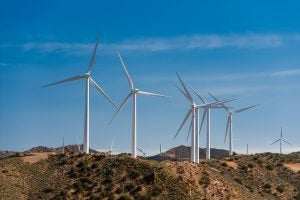 The Los Angeles City Council recently passed a unanimous resolution requiring Los Angeles Department of Water and Power – the largest municipally-owned utility in the country — to study how the city can achieve a 100% clean energy future. With help from research partners, including academic institutions, the U.S. Department of Energy, and environmental and consumer groups, the study has the potential to become a foundational roadmap for running the utility on only clean and renewable energy.
The Los Angeles City Council recently passed a unanimous resolution requiring Los Angeles Department of Water and Power – the largest municipally-owned utility in the country — to study how the city can achieve a 100% clean energy future. With help from research partners, including academic institutions, the U.S. Department of Energy, and environmental and consumer groups, the study has the potential to become a foundational roadmap for running the utility on only clean and renewable energy.
California currently has a goal to reduce greenhouse gas emissions 40% below 1990 levels by 2030, with half of the state’s energy supply powered by renewable electricity by 2030. To achieve these targets, it is imperative for the state to look seriously at how to get off of fossil fuel dependency for our energy needs. Utilities and cities can be the key to reaching those climate goals.
Mayor Garcetti’s LA Sustainability pLAn, sets even more stringent emission reduction targets than that of the state, calling on Los Angeles to reduce emissions by 45% by 2025, 60% by 2035, and 80% by 2050, all against a 1990 baseline. As one of eighteen U.S. cities committing to a clean energy future, L.A. is demonstrating tremendous leadership for others to follow suit.
Getting off of Natural Gas
California utilities currently rely on a massive amount of natural gas to generate electricity for millions of homes and businesses. The main component of natural gas is methane — a strong climate pollutant that has 80 times the warming power of carbon dioxide in the short-term. As the second largest natural gas consumer in the country, California’s methane pollution from natural gas transmission, distribution, and production is a major contributor to greenhouse gas emissions.
In 2014, the state’s oil and gas industry emitted approximately 270,000 tons of methane, nearly three times as much as was released by the Aliso Canyon storage facility in the recent disaster. This pollution has the same climate impact over the first 20 years after release as driving over 4.5 million cars for a year.
Real Public Health Concerns
There are also pressing public health concerns with the current energy system. Methane and volatile organic compound leaks from oil and gas facilities directly increase ozone smog levels, which aggravate asthma and other cardiac and respiratory ailments. And for three years straight, Los Angeles has been ranked the number one most contaminated city in the country for ozone pollution.
Low-income communities, and communities of color are burdened with outsized health and climate impacts associated with both oil and gas industry activities, and from the massive combustion of natural gas to make electricity. In Los Angeles, nearly half a million Latinos live within a half mile of an oil and gas facility, and all live in an air basin where nearly 17 separate power plants combust gas to supply electricity. Latino children suffer thousands of asthma attacks and missed school days due to the methane pollution and ozone smog resulting from these far ranging oil and gas activities.
Moving toward non-polluting renewable sources of energy means our most overburdened and vulnerable neighbors will benefit tremendously.
The Clean Energy Opportunity is Ripe in the City of Angels
LADWP delivers electricity and water to four million customers, and such as, is the largest municipal utility in the state and country. California’s publicly owned utilities supply about a quarter of the electricity in the state. Currently, only a quarter of Los Angeles is powered by renewable energy, mainly wind power, while the rest is powered by coal and natural gas.
With last month’s announcement of the study — along with the new direction coming from the Los Angeles city council and statewide legislation by way of SB 350 and SB 32 — we now have a real opportunity to upgrade LADWP’s 100-year old system.
The biggest obstacles to achieving the renewable energy goals revolve around how to effectively make a switch as fast as possible, while maintaining energy reliability and keeping customer bills manageable. In order to get the city’s renewable energy portfolio to 100%, there will need to be a significant increase in the rapid deployment of renewable technology, and it must be done so in a way that minimizes costs.
LADWP is already committed to getting off of coal completely by 2025. Now, as the renewable energy portfolio gets built up in Los Angeles, the same kind of commitment needs to happen for natural gas. The good news is that the clean technology currently does exist, and continues to advance at lightning speed.
Despite these challenges it is clear that switching to clean energy is vital for reducing anthropogenic climate impacts, as well as alleviating community health impacts. If the second largest city in the country can successfully transition into a full green economy, then Los Angeles will set a clear example of what steps must be taken to achieve this outcome in other metropolises. Our climate and our communities need this kind of leadership now.
Photosource: Flickr, allanjder









